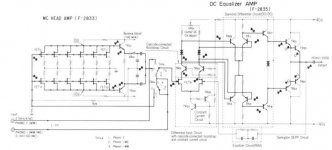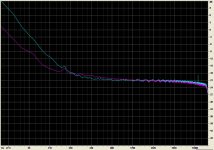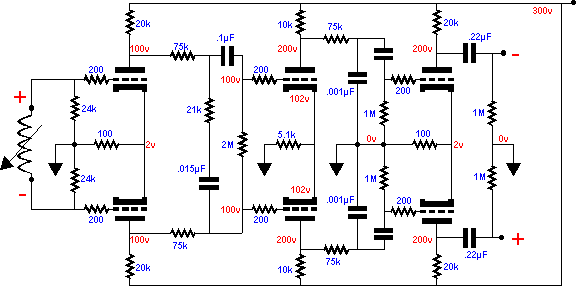Dated designs, somewhat impractical with the availability of today's devices. Why not a transformer, instead?
I got some 2SK170's from someone on the forum and ran a quick comparison with the BF862. Not perfect but not too shabby for something you can pick up for 15 cents. In headphones I couldn't really detect an important difference. The comparison is at 1mA Id and actually the 2SK170 has a hint of G-R noise but a little less 1/f. The flat band is ~1.2nV.
Attachments
Am I missing something or is there a 0.1 uF coupling cap missing in the bottom plate circuit of the first valve ??
You're missing something. The 2M resistor along with the single cap keeps the DC on the two second stage grids equal and elevated in the face of any offset in the DC of the first stage plates.
edit: What are the tubes? Something like a 417 or 6HA5?
edit: What are the tubes? Something like a 417 or 6HA5?
john curl said:Dated designs, somewhat impractical with the availability of today's devices. Why not a transformer, instead?
Why not ?? After all what are we dealing with here but a diamond tip riding through a plastic groove which hopefully has minimal crud, minimal warpage and can hopefully maintain its elasticity for the next play 🙁 Then there is the turntable itself a concept which dates back to Edison's first design 🙁
Maybe this whole thread is just academic 😉
SY said:You're missing something. The 2M resistor along with the single cap keeps the DC on the two second stage grids equal and elevated in the face of any offset in the DC of the first stage plates.
edit: What are the tubes? Something like a 417 or 6HA5?
Yes you are right 😉 You get differential mode operation without the problems of DC imbalance 😉
>Yes you are right
>You get differential mode operation without
>the problems of DC imbalance
You can do the same with SS.
But you have to embrace capacitors.
I would venture to say that a part of
the 'magic' of tubes is that they are
usually capacitor coupled and therefore
each stage can run optimumly biaswise
without consideration for subsequent
or previous stages.
>You get differential mode operation without
>the problems of DC imbalance
You can do the same with SS.
But you have to embrace capacitors.
I would venture to say that a part of
the 'magic' of tubes is that they are
usually capacitor coupled and therefore
each stage can run optimumly biaswise
without consideration for subsequent
or previous stages.
could you just switch out jfets for the tubes and
bring the Vcc down to ~30 V (or whatever) ?
you wouldn't need the complements .....
bring the Vcc down to ~30 V (or whatever) ?
you wouldn't need the complements .....
It doesn't work very well for fets. Circuits should match the advantages and the disadvantages of the devices used. That is what creates quality circuits.
would it work at all with jfets ?john curl said:It doesn't work very well for fets. Circuits should match the advantages and the disadvantages of the devices used. That is what creates quality circuits.
in case p channel ones become obsolete ?
What wasn't my question.
(whether or not to use jfets)
just ..... would they work ?
even if crudely ?
(whether or not to use jfets)
just ..... would they work ?
even if crudely ?
Anything can work crudely, that should be obvious. They just won't work optimally. It appears that you have little experience in this sort of transposition. Perhaps, the input pair could be changed to fets in order to lower the noise floor somewhat.
Jan, these would qualify as SMD (ignoring that they're unobtainium), don't you think? (look at the match, for size relationships)
Actually they are obtainium. MPD still makes them:
http://www.mpdcomponents.com/pdfs/planarbytype.pdf
John
- Status
- Not open for further replies.
- Home
- Amplifiers
- Solid State
- John Curl's Blowtorch preamplifier



